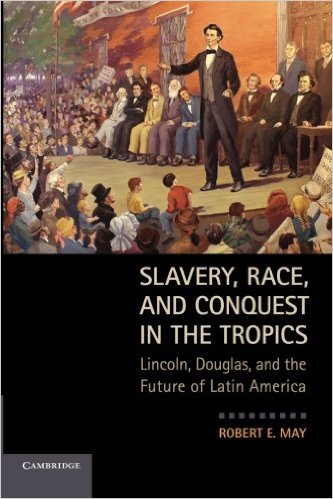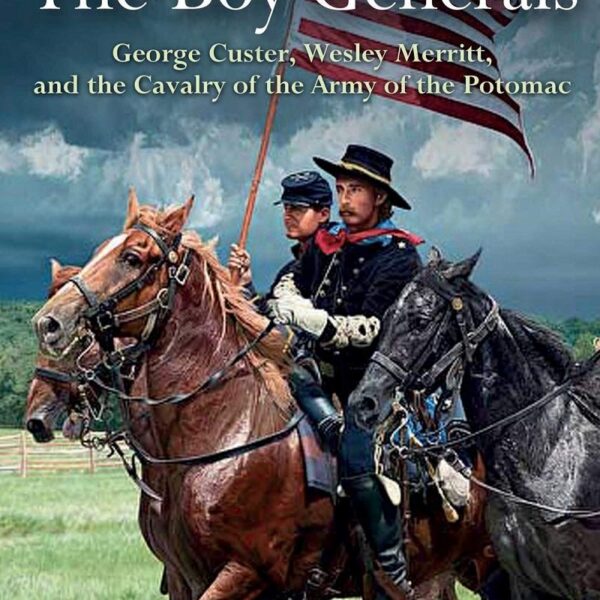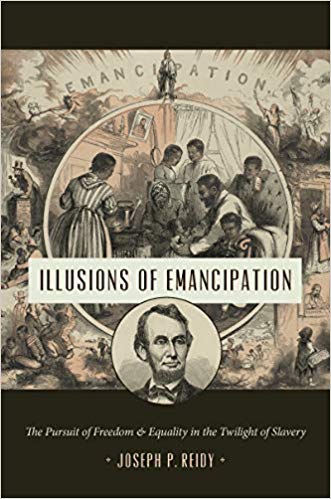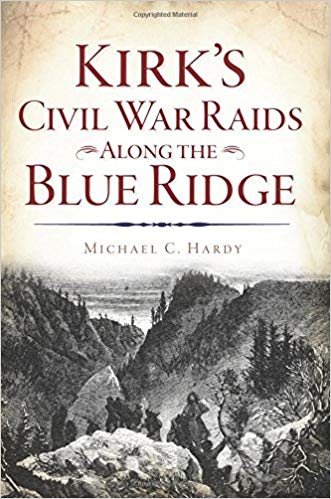Slavery, Race, and Conquest in the Tropics: Lincoln, Douglas, and the Future of Latin America by Robert E. May. Cambridge University Press, 2013. Paper, ISBN: 978-0521132527. $26.99.
 For decades, scholars and popular historians have been providing a steady supply of books to feed the seemingly never-ending interest in Abraham Lincoln’s relationship with his chief political adversary, Stephen A. Douglas. Given this surfeit of material devoted to what Robert E. May aptly describes as “arguably the most famous political rivalry in the history of the United States,” one must naturally question whether there is anything original that can be contributed on the subject (2). Offering a new lens through which to view the Lincoln-Douglas contest, May, a history professor at Purdue University and leading authority on nineteenth-century American expansionist visions and filibustering escapades in Latin America, demonstrates that the topic has not yet been exhausted. While Lincoln and Douglas were primarily concerned with the expansion of slavery into the western territories of the United States, May argues that the future of Latin America was an important “subtext” to their dispute, as it “lurked in the West’s shadow” and provided a “‘Latin beat’” to the debate (3, 4).
For decades, scholars and popular historians have been providing a steady supply of books to feed the seemingly never-ending interest in Abraham Lincoln’s relationship with his chief political adversary, Stephen A. Douglas. Given this surfeit of material devoted to what Robert E. May aptly describes as “arguably the most famous political rivalry in the history of the United States,” one must naturally question whether there is anything original that can be contributed on the subject (2). Offering a new lens through which to view the Lincoln-Douglas contest, May, a history professor at Purdue University and leading authority on nineteenth-century American expansionist visions and filibustering escapades in Latin America, demonstrates that the topic has not yet been exhausted. While Lincoln and Douglas were primarily concerned with the expansion of slavery into the western territories of the United States, May argues that the future of Latin America was an important “subtext” to their dispute, as it “lurked in the West’s shadow” and provided a “‘Latin beat’” to the debate (3, 4).
Led by James G. Randall, revisionist historians of the 1920s and 1930s tended to emphasize the similarities between Lincoln and Douglas, such as their faith in democratic government, belief in the supremacy and perpetuity of the Union, and fear that abolitionists threatened the Union with were their dangerous advocacy of an immediate end to slavery followed by racial equality. After the Second World War, the revisionist interpretation fell out of favor as historians increasingly viewed the Civil War as an inevitable conflict over slavery. Douglas, once the darling of revisionists due to his unwavering commitment to popular sovereignty and efforts to avoid war through political compromise, came to be seen as one of the principal instigators of the conflict as evidenced by his role in engineering passage of the Kansas-Nebraska Act and his avowed moral indifference to slavery. May’s work persuasively underscores the fundamental divide between Lincoln and Douglas over the issues of slavery, Manifest Destiny, and territorial expansion into Latin America, yet he also believes that their differences over slavery “remained narrow for many years,” and that they shared some similar views on race (22). Douglas was an outspoken champion of expansion who favored the “reannexation” of Texas, and, as a committed Anglophobe, was ready to go to war with Great Britain over the Oregon boundary. An enthusiastic supporter of the U.S.-Mexican War, Douglas attempted to obtain a commission in the army, while Lincoln opposed the war and harshly criticized President Polk during his single term in the U.S. House of Representatives.
As David M. Potter observed in his seminal work, The Impending Crisis, the political crisis of the 1850s did not occur in a vacuum. While Potter provided only a brief overview of the connection between domestic politics and U.S. relations with Latin America, May’s work illustrates how closely connected these issues were. Through research into primary sources, May recovers the oft-neglected relationship between the Kansas-Nebraska Act and Caribbean expansion. In addition to supporting war with Mexico and championing popular sovereignty, Douglas also advocated the annexation of Cuba and praised the filibustering exploits of William Walker. Douglas envisioned white American settlement of not only the western territories of the United States, but Latin America as well. His Republican adversaries, on the other hand, expressed “tropical worries” that this expansionist vision was merely a ploy to spread slavery throughout the Western Hemisphere (127). May delineates how the issue of Caribbean expansion was very much entwined with the debate over slavery. Republicans opposed both the expansion of slavery into the federal territories and the acquisition of additional territory in Latin America, yet Douglas’s appeal to Southerners hinged on his support for acquiring new territories south of the border. By 1860, territorial expansion was one of the few issues that Northern and Southern Democrats could agree upon, as the 1860 platforms of both factions contained planks endorsing the annexation of Cuba. If Southerners could idealize the freebooting William Walker, some in the North wondered why they could not admire John Brown’s raid on Harpers Ferry.
May’s work demonstrates the extent to which Caribbean issues were very much part of the political landscape in the years immediately preceding the Civil War. Though Lincoln did not explicitly mention the issue of Latin American expansion following the 1858 Senate campaign against Douglas, his fellow Republicans expressed “genuine fears” that a Democratic victory in the 1860 presidential election would lead to the acquisition of territory in Latin America (201). As the Union crumbled following Lincoln’s election, May notes that the Caribbean was a factor during the secession crisis. Republicans editorialized that the same spirit that animated William Walker’s filibustering expeditions was inspiring Southern secessionists. Lincoln joined other Republicans in opposing John J. Crittenden’s proposed compromise to save the Union because, among other things, it encouraged the acquisition of territory in Latin America. By re-instituting the Missouri Compromise Line, extending it to the Pacific Ocean, and guaranteeing slavery in all territory south of the line that was then under federal control (or may be in the future), the Crittenden Compromise would, in Lincoln’s view, only foster new attempts to acquire territory for the purpose of expanding slavery. According to May, this opposition to the Crittenden Compromise is evidence of “how consistently Caribbeanized Lincoln’s message was” (215).
While they had been bitter rivals for many years, Lincoln and Douglas agreed that the Union must be preserved—even if it required the use of military force. At a meeting that took place at the White House on the day Fort Sumter surrendered, Douglas endorsed Lincoln’s decision to issue a proclamation calling for troops to suppress the rebellion. Douglas then spent the few remaining months of his life rallying support for the Union cause. In an address to the Illinois State Legislature, Douglas “struck a tropical theme” when he asserted that if the rebellion succeeded the United States would be reduced to a state of anarchy, similar to that which prevailed in Mexico (227). In making his case for the preservation of the Union, Douglas was, as May observes, echoing sentiments that Lincoln and other Republicans had expressed in their denunciations of secession. Thus, not only did Latin America inform debates over slavery and Manifest Destiny, but it was also invoked as a symbol of the chaos and failed republicanism that the United States must not become. At the time of his death on June 3, 1861, Douglas had seemingly disavowed his support for territorial expansion into Latin America and instead advocated a customs union between the nations of the Western Hemisphere. Given this change and his support for Lincoln’s war to save the Union, May wonders whether he and Lincoln would have found more areas of agreement if he had lived.
President Lincoln did not share the Democratic perception of Latin America as an area ripe for American territorial expansion. Instead, as Lincoln widened the aims of the war to include the destruction of slavery, he viewed the Caribbean as a “haven where African Americans could achieve the equality and progress that eluded them in the United States” (276). May tackles the controversial subject of Lincoln’s support for colonization and details his efforts to utilize Latin America as a place where former American slaves could be sent. A variety of schemes were explored, including a proposal to establish a colony that would mine coal in Chiriqui and sell it to the United States, but a host of factors undermined these proposals, including opposition from Latin American leaders and, most importantly, the unwillingness of African Americans to participate. Only one colony was established, and the brief experiment involving just over 450 persons on Ile-a-Vache, Haiti, was such a disaster that Lincoln ordered a ship dispatched in 1864 to pick up the survivors and return them to the United States.
May argues that this support for colonization “evidences Lincoln’s racism,” and merits “censure” (234, 272). Though May believes Lincoln remained interested in exploring possible sites for colonies in Latin America following the issuance of his Final Emancipation Proclamation, he is not fully persuaded by Benjamin Butler’s testimony that Lincoln remained an enthusiastic colonizationist just days before his assassination. Notwithstanding his strong words condemning Lincoln’s support for colonization, May also points out that Lincoln’s vision for colonization was predicated upon voluntary participation and was not compulsory. Furthermore, only the Ile-a-Vache experiment was attempted, and, after its failure, no other colonization scheme was implemented. Though May and other historians have made much of Lincoln’s appointment of James Mitchell as his “colonization czar,” was Lincoln naïve enough to think that one person in the federal government would be sufficient to supervise the logistics of moving hundreds of thousands— if not millions—of persons from the United States to Latin American colonies? May concludes that Lincoln’s interest in colonization was an “end run” around the problem of integrating former slaves into a society that was overwhelmingly in favor of white supremacy; yet given the pathetic achievements of Lincoln’s colonization efforts, it seems like a half-hearted end run at best (273). Lincoln undoubtedly realized that if African Americans embraced colonization, the task of restoring the Union would be much simplified, but—considering all the obstacles to an enterprise that sought to relieve the United States of its African American population and the inability of the American Colonization Society to generate much enthusiasm for Liberia after decades of effort— colonization was likely doomed from the start. Whether Lincoln believed all of these obstacles were possible or desirable to overcome will remain a matter of speculation.
Despite Lincoln’s failed attempt to use Latin America as a destination for former slaves, he became something of a hero to many Latin Americans. In preserving the Union and abolishing slavery, Benito Juarez, Domingo Sarmiento, and others perceived Lincoln as a champion of republicanism and freedom. As president, Lincoln ignored the Monroe Doctrine, eschewed the expansionist rhetoric of his rival Douglas, and evinced little interest in pursuing the interventionist policies of his Democratic predecessors. This change in tone and policy further endeared Lincoln to Latin Americans such as Jose Marti and Federico Pezet, the Peruvian ambassador to the United States, who, in 1921, delivered a moving tribute to Lincoln at his tomb in Springfield. Clearly, Latin America was neither a priority for Lincoln during his presidency nor the most significant issue that divided him and Douglas, but May’s work offers original insights on their political rivalry and adds a fascinating new layer to the complex history of this tumultuous era.
Matthew Norman teaches history at the University of Cincinnati, Blue Ash College.




